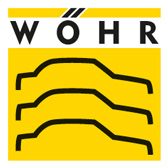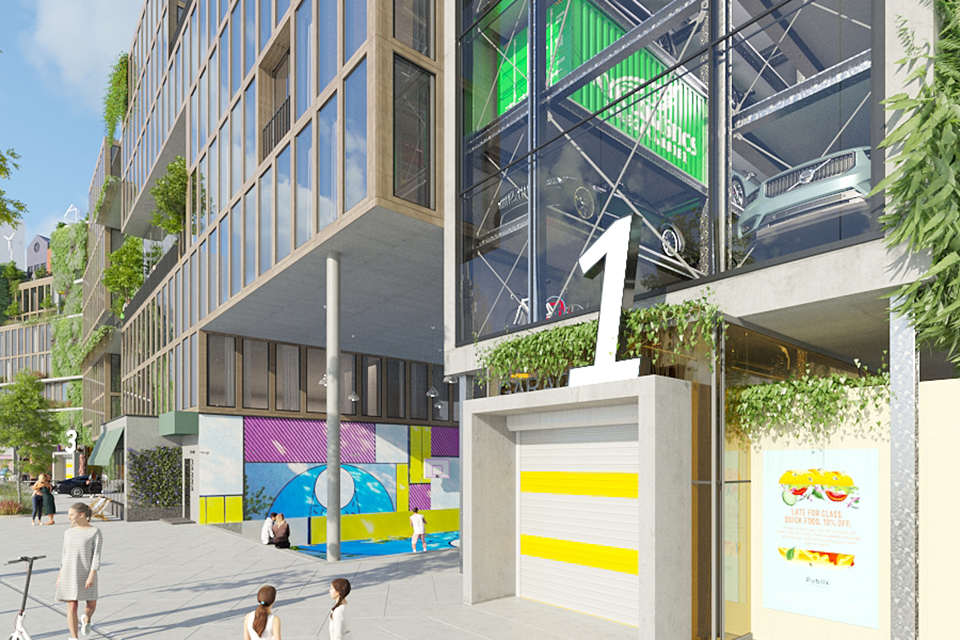Multiplicity Instead of Parking Spaces
- Text: Marco Eisenack
- Illustrations: Heller Designstudio + Partner
The new Quartier Dock by Heller Designstudio makes the carpark the impulse generator for the quarter. Programmed with a variety of uses, the modular building system engenders qualities typical of urban life – even in new development areas at the edge of town.

If we want to create more space for environmentally friendly mobility in our progressively densified cities, and more green space for climate resilient districts, then parking spaces are aprime candidate for elimination. With the concept of the Quartier Dock, developed by Marcel Heller on commission from WÖHR, parking places vanish from public space and become the ‘core users’ of buildings that also offer space for further functions, which the quarter requires, some of them all too often absent from newly developing areas: lively ground-floor zones, spaces for young people and creative enterprises, open spaces on roofs, ample room for sporting activities, evening events, and much more.
At IAA Mobility, which took place in Munich in September of 2021, the Quartier Dock was presented as a new, sustainable mobility concept that could serve as the basis for enhancing residential districts. “Here, the narrative of parking space is inverted,” explains Marcel Heller. “It is no longer a question of isolating automobiles somewhere, making them as invisible as possible. The aim now is to convert the need for mobility into the motor of the quarter. This results in the potential for additional uses.” On the basis of a fully automated parking system in combination with additional usage components, Heller has conceived a modular building that is used additively from the ground floor all the way to the roof terrace.
Mobility needs are in a state of flux
According to the German Environment Agency, automobile traffic increased more than 20% between 1995 and 2019. During the same period, carbon dioxide emissions from private vehicles rose 5.1%. In order to reach the Paris climate goals, CO2 emissions produced by traffic alone must be reduced by more than onethird in the coming ten years. Only if mobility is reconceived will we be able to adhere to the Accords.
Heller is convinced that mobility will become ever more diverse: the bicycle, the electric bike, the cargo bike, the electric motorbike, the electric scooter, and the electric auto. In the future, depending upon the occasion, the weather, and the time of day, we will choose from a variety of transport resources. “In cities, people are already aware of the value of sharing vehicles. Which is why we need a mobility hub,” explains Heller. The Quartier Dock makes mobility offerings so attractive that people will no longer find it necessary to acquire private automobiles. At the same time, they will be more mobile than ever before: these days, an app on a cell phone offers better solutions than a car key in the hand.
According to observers, it is precisely the degree of user-friendliness that harbors such potential for the Quartier Dock. With “Parksafe,” WÖHR’s integrated, automatic parking system, bicycles and cars are stacked in a space-saving way, and return quickly to street level via elevator on demand. Users wait in safe, bright public spaces. No staircases, no dark, subterranean garages. And the automatic parking system uses circa 60% less parking surface when compared with a conventional garage.

Saving space and using it differently
The guiding idea behind the concept of the WÖHR Quartier Dock is to integrate public life through the use of modular construction methods: a multiplicity of utilizations are conceivable, ranging from gastronomy, retail, fitness studios, and cinemas, to daycare and youth centers, and all the way to boulder walls in outdoor areas and rooftop urban gardening. By virtue of its position at the entrance to a residential area, the hub functions like a harbor from which users can depart or dock. At the same time, the building provides protection from street noise, and bundles together functions that might be less than welcome in residential zones.
The Quartier Dock is conceptualized as an optimized user interface for a future-oriented district. The fact that the Quartier Dock is conceived as a modular construction system consisting of recyclable metal in accordance with cradle-to-cradle principles has ensured it a particularly good reception among representatives from municipal politics, administrators, and civil society. And once even this projected future in turn becomes the past, it will still be possible to build upon it.
Projektreportage 2
Architects
The Heller Designstudio, a creative office based in Stuttgart and Shanghai, develops architecture worldwide for brands. As conceptual advisors and architects, they design and position architecture, interiors, and digital information within a total context, always seeking to launch the working process from a zero point. In order to provide an optimal basis for decision-making, each project is accompanied from the start by high-quality 3D visualizations. Projects include showrooms, exhibition design, trade fairs, and hotels, and extend all the way to workplace environments.



